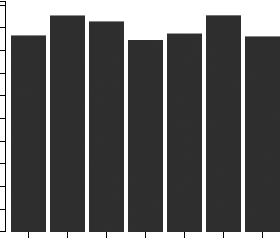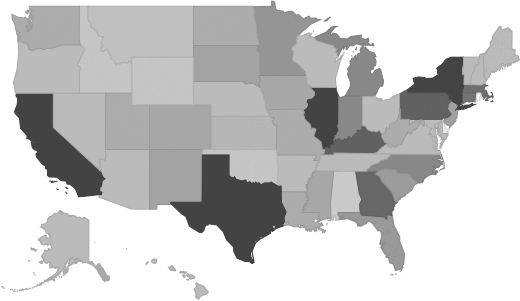Human Rights Organizations - Market Size, Financial Statistics, Industry Trends
Industry Overview
This U.S. industry comprises establishments primarily engaged in promoting causes associated with human rights either for a broad or specific constituency. Establishments in this industry address issues, such as protecting and promoting the broad constitutional rights and civil liberties of individuals and those suffering from neglect, abuse, or exploitation; promoting the interests of specific groups, such as children, women, senior citizens, or persons with disabilities; improving relations between racial, ethnic, and cultural groups; and promoting voter education and registration. These organizations may solicit contributions and offer memberships to support these causes. Illustrative Examples: Civil liberties organizations Senior citizens advocacy organizations Human rights advocacy organizations Veterans rights organizations Cross-References. Establishments primarily engaged in--Source: U.S. Census Bureau
Human Rights Organizations Market Size
This report includes historical and forecasted market sizes and industry trends for Human Rights Organizations. It reveals overall market dynamics from 2020 through the present, and predicts industry growth or shrinkage through 2030. Revenue data include both public and private companies in the Human Rights Organizations industry.| Historical | Forecasted | ||||||||||
|---|---|---|---|---|---|---|---|---|---|---|---|
| 2020 | 2021 | 2022 | 2023 | 2024 | 2025 | 2026 | 2027 | 2028 | 2029 | 2030 | |
| Market Size (Total Revenue) | Included in Report |
||||||||||
| % Growth Rate | |||||||||||
| Number of Companies | |||||||||||
| Total Employees | |||||||||||
| Average Revenue per Company | |||||||||||
| Average Employees per Company | |||||||||||
Industry Revenue ($ Billions)

Industry Forecast ($ Billions)

Pell Research's advanced econometric models forecast five years of industry growth based on short- and long-term trend analysis. Market size statistics include revenue generated from all products and services sold within the Human Rights Organizations industry.
Geographic Breakdown by U.S. State
Human Rights Organizations market share by state pinpoints local opportunities based on regional revenue statistics. Growth rate for each state is affected by regional economic conditions. Data by state can be used to locate profitable and nonprofitable locations for Human Rights Organizations companies in the United States.Industry Revenue by State [Sample]

Distribution by Company Size
| Company Size | All Industries | Human Rights Organizations |
|---|---|---|
| Small Business (< 5 Employees) | Included |
|
| Small Business (5 - 20) | ||
| Midsized Business (20 - 100) | ||
| Large Business (100 - 500) | ||
| Enterprise (> 500) | ||
Industry Income Statement (Average Financial Metrics)
Financial statement analysis determines averages for the following industry forces:- Cost of goods sold
- Compensation of officers
- Salaries and wages
- Employee benefit programs
- Rent paid
- Advertising and marketing budgets
The report includes a traditional income statement from an "average" Human Rights Organizations company (both public and private companies are included).
| Industry Average | Percent of Sales | |
|---|---|---|
| Total Revenue | Included |
|
| Operating Revenue | ||
| Cost of Goods Sold (COGS) | ||
| Gross Profit | ||
| Operating Expenses | ||
| Operating Income | ||
| Non-Operating Income | ||
| Earnings Before Interest and Taxes (EBIT) | ||
| Interest Expense | ||
| Earnings Before Taxes | ||
| Income Tax | ||
| Net Profit | ||
Average Income Statement

Cost of Goods Sold
Salaries, Wages, and Benefits
Rent
Advertising
Depreciation and Amortization
Officer Compensation
Net Income
Financial Ratio Analysis
Financial ratios allow a company's performance to be compared against that of its peers.| Financial Ratio | Industry Average |
|---|---|
| Profitability Ratios | Included |
| Profit Margin | |
| ROE | |
| ROA | |
| Liquidity Ratios | |
| Current Ratio | |
| Quick Ratio | |
| Activity Ratios | |
| Average Collection Period | |
| Asset Turnover Ratio | |
| Receivables Turnover Ratio | |
| Inventory Conversion Ratio |
Products and Services Mix
Product lines and services in the Human Rights Organizations industry accounting for the largest revenue sources.| Product Description | Description | Revenue ($ Millions) |
|---|---|---|
| Industry total | Included |
|
| Contributions, gifts, & grants - private | ||
| Membership services | ||
| Contributions, gifts, & grants - government | ||
| Investment income, including interest & dividends | ||
| All other revenue | ||
| Social assistance | ||
| All other operating receipts | ||
| Gains (losses) from assets sold | ||
| Resale of merchandise | ||
Compensation and Salary Surveys
Salary information for employees working in the Human Rights Organizations industry.| Title | Percent of Workforce | Bottom Quartile | Average (Median) Salary | Upper Quartile |
|---|---|---|---|---|
| Management Occupations | 13% |
Included |
||
| Top Executives | 6% | |||
| Chief Executives | 1% | |||
| General and Operations Managers | 5% | |||
| General and Operations Managers | 5% | |||
| Business and Financial Operations Occupations | 14% | |||
| Business Operations Specialists | 12% | |||
| Community and Social Service Occupations | 17% | |||
| Counselors, Social Workers, and Other Community and Social Service Specialists | 17% | |||
| Miscellaneous Community and Social Service Specialists | 12% | |||
| Social and Human Service Assistants | 8% | |||
| Arts, Design, Entertainment, Sports, and Media Occupations | 6% | |||
| Media and Communication Workers | 6% | |||
| Personal Care and Service Occupations | 11% | |||
| Animal Care and Service Workers | 6% | |||
| Nonfarm Animal Caretakers | 6% | |||
| Nonfarm Animal Caretakers | 6% | |||
| Office and Administrative Support Occupations | 17% | |||
| Other Office and Administrative Support Workers | 6% | |||
Government Contracts
The federal government spent an annual total of $28,062,995 on the Human Rights Organizations industry. It has awarded 238 contracts to 138 companies, with an average value of $203,355 per company.Top Companies in Human Rights Organizations and Adjacent Industries
| Company | Address | Revenue ($ Millions) |
|---|---|---|
Included |
||
